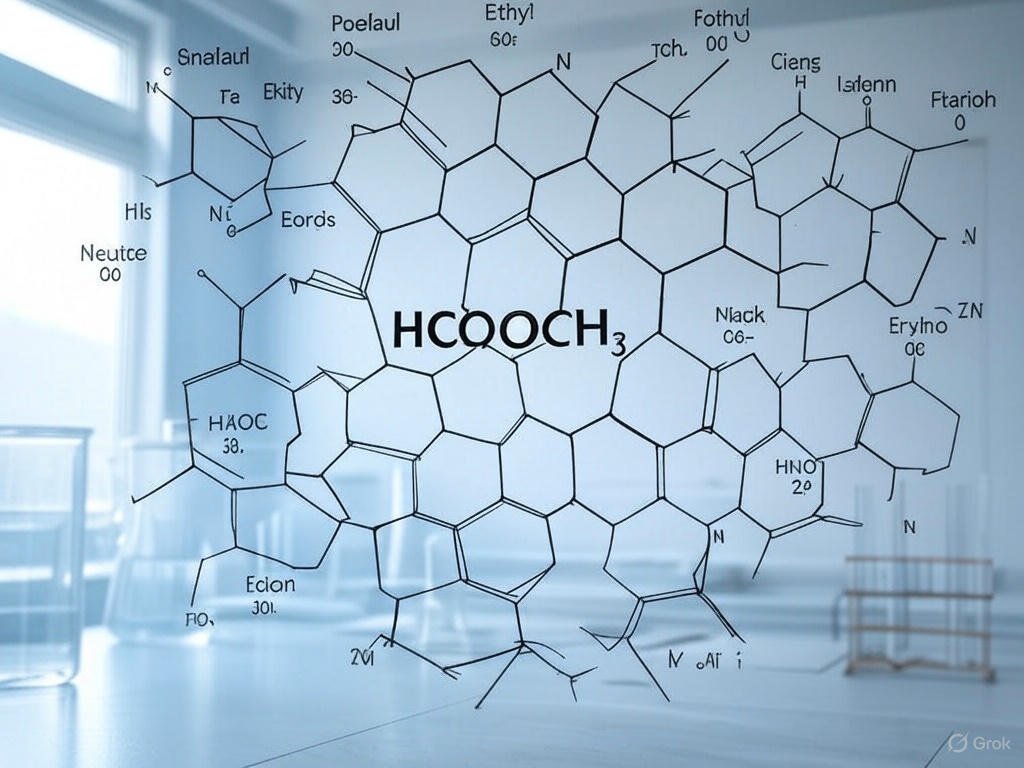Introduction
What sets methyl formate apart from other esters in organic chemistry? Methyl formate (HCOOCH₃), a simple ester, is often compared to its counterparts like ethyl formate, methyl acetate, and ethyl acetate due to its unique properties and reactivity. Searches such as “hcooch ch2 h2o vs ethyl formate” reflect interest in understanding these differences, whether for academic study or practical applications. This article provides a detailed “methyl formate comparison,” examining physical properties, reactivity, and applications of methyl formate alongside ethyl formate (HCOOC₂H₅), methyl acetate (CH₃COOCH₃), and ethyl acetate (CH₃COOC₂H₅). Aimed at advanced chemistry students and researchers, we’ll break down how structural variations influence their behavior, offering insights into their roles in organic chemistry. Let’s dive into the comparison, covering properties, reactivity, applications, and key takeaways.
Understanding Esters: A Quick Overview
What Are Esters in Organic Chemistry?
Esters are organic compounds formed from the reaction of an acid (typically a carboxylic acid) and an alcohol, characterized by the general structure RCOOR’, where R and R’ are alkyl or aryl groups. They are widely studied in “organic chemistry esters” for their roles in synthesis, solvents, and fragrance industries. Esters are known for their pleasant, fruity odors and volatility, making them valuable in both industrial and natural contexts.
Methyl formate (HCOOCH₃) is one of the simplest esters, with a formate group (HCOO-) and a methyl group (-CH₃). Its small size and high volatility make it a frequent subject of comparison with other esters. In this analysis, we’ll compare it to ethyl formate (HCOOC₂H₅), which has a larger ethyl group; methyl acetate (CH₃COOCH₃), with an acetate group; and ethyl acetate (CH₃COOC₂H₅), a larger ester with both an acetate and ethyl group. Searches like “hcooch ch2 h2o” often point to methyl formate in comparative studies or reaction contexts, such as hydrolysis.
Physical Properties Comparison
How Do Their Physical Properties Differ?
Physical properties like boiling point, solubility, and odor are influenced by the molecular structure of esters, particularly the size of the alkyl groups and the nature of the acid component. Here, we compare methyl formate with ethyl formate, methyl acetate, and ethyl acetate to highlight these differences in “ester properties.”
Boiling Point and Volatility
- Methyl Formate: Boiling point ~31.5°C. Its small size (C₂H₄O₂) makes it highly volatile, evaporating quickly, which suits applications needing fast drying.
- Ethyl Formate: Boiling point ~54°C. The larger ethyl group (C₂H₅) increases intermolecular forces, reducing volatility compared to methyl formate.
- Methyl Acetate: Boiling point ~57°C. Slightly less volatile than methyl formate due to the acetate group (CH₃COO-), which adds a methyl group to the acid component.
- Ethyl Acetate: Boiling point ~77°C. The least volatile, with both a larger acid (acetate) and alcohol (ethyl) component, leading to stronger intermolecular interactions.
Solubility
- Methyl Formate: Slightly soluble in water (~230 g/L at 20°C) due to its polar ester group, but fully miscible with organic solvents like ethanol.
- Ethyl Formate: Less soluble in water (~85 g/L), as the larger ethyl group reduces polarity, though it remains miscible with organic solvents.
- Methyl Acetate: Solubility in water ~250 g/L, slightly higher than methyl formate, due to the acetate group’s polarity.
- Ethyl Acetate: Solubility in water ~80 g/L, the least water-soluble due to its larger non-polar ethyl group, but widely used in organic solvents.
Odor
- Methyl Formate: Sweet, fruity, with an apple or rum-like scent, often used in flavoring.
- Ethyl Formate: Sharp, rum-like, more pungent than methyl formate, common in fragrances.
- Methyl Acetate: Fruity, apple-like, but softer and less sharp than ethyl formate.
- Ethyl Acetate: Fruity, with a nail polish-like scent due to its use in solvents, less suited for flavors.
| Ester | Boiling Point (°C) | Solubility in Water (g/L) | Odor |
|---|---|---|---|
| Methyl Formate | 31.5 | 230 | Sweet, fruity (apple/rum-like) |
| Ethyl Formate | 54 | 85 | Sharp, rum-like |
| Methyl Acetate | 57 | 250 | Fruity, apple-like |
| Ethyl Acetate | 77 | 80 | Fruity, nail polish-like |
Reactivity Differences
How Do Their Reactivities Compare?
The reactivity of esters is influenced by the size of the alkyl groups and the electron-withdrawing nature of the acid component. Methyl formate’s small size and formate group make it distinct in reactivity compared to ethyl formate, methyl acetate, and ethyl acetate. Let’s explore these differences, particularly in the context of “hcooch ch2 h2o vs ethyl formate.”
Hydrolysis Rates
Hydrolysis, the reaction of an ester with water to form an acid and alcohol, is a key reaction for esters. Methyl formate undergoes faster hydrolysis due to its small methyl group, which offers minimal steric hindrance, allowing water or hydroxide ions to attack the carbonyl carbon easily. Ethyl formate, with a larger ethyl group, hydrolyzes more slowly due to increased steric hindrance. Methyl acetate has a moderate hydrolysis rate, as the acetate group (CH₃COO-) is less electron-withdrawing than the formate group, reducing the carbonyl’s electrophilicity. Ethyl acetate is the slowest, with both a larger alkyl group and the less reactive acetate group, making the carbonyl less accessible to nucleophiles.
Stability to Heat and Light
Methyl formate is less stable to heat and light due to its high volatility and small size, leading to faster decomposition under thermal or photolytic conditions. Ethyl formate is slightly more stable, as the ethyl group provides a modest increase in molecular stability. Methyl acetate and ethyl acetate are more stable, benefiting from larger alkyl groups that distribute energy more effectively, reducing the likelihood of bond cleavage under heat or UV exposure.
Reactivity with Nucleophiles
In reactions like aminolysis (reaction with amines), methyl formate shows high reactivity due to the formate group’s strong electron-withdrawing effect, which enhances the electrophilicity of the carbonyl carbon. Ethyl formate is slightly less reactive, as the ethyl group donates electron density, reducing the carbonyl’s reactivity. Methyl acetate and ethyl acetate are less reactive with nucleophiles, as the acetate group’s methyl substituent donates electrons, further stabilizing the carbonyl and slowing nucleophilic attack.
Applications: Where They Diverge
Comparing Applications of Methyl Formate and Other Esters
The distinct properties of methyl formate, ethyl formate, methyl acetate, and ethyl acetate lead to varied applications in “organic chemistry esters,” from solvents to fragrances and chemical intermediates.
Solvent Use
- Methyl Formate: Its high volatility (boiling point ~31.5°C) makes it ideal for quick-drying coatings, such as in automotive paints or lacquers, where rapid evaporation is needed.
- Ethyl Formate: Less commonly used as a solvent due to its sharper odor and moderate volatility, but occasionally applied in niche coatings.
- Methyl Acetate and Ethyl Acetate: Both are widely used solvents. Methyl acetate is used in fast-drying paints, while ethyl acetate, with its higher boiling point (~77°C), is a staple in paints, adhesives, and nail polish removers due to its slower evaporation and stability.
Fragrance and Flavor
- Methyl Formate: Adds fruity, apple/rum-like notes in specific flavor applications, such as in beverages or candies.
- Ethyl Formate: Known for its sharp, rum-like scent, it’s used in perfumes and flavorings to mimic rum or fruit notes.
- Methyl Acetate: Has a softer, apple-like scent, used in milder fruity flavors.
- Ethyl Acetate: Its nail polish-like scent limits its use in flavors, but it’s used in perfumes for a fruity undertone.
Chemical Intermediates
- Methyl Formate: Serves as an intermediate in formic acid production and other syntheses, leveraging its high reactivity.
- Ethyl Formate: Less common as an intermediate due to slower reactivity.
- Methyl Acetate and Ethyl Acetate: Used as intermediates in larger syntheses, such as producing acetic acid derivatives or other esters.
Key Application Differences:
- Methyl formate excels in quick-drying solvents.
- Ethyl formate is preferred for rum-like fragrances.
- Methyl acetate suits milder flavor applications.
- Ethyl acetate dominates as a stable solvent in paints and adhesives.
Methyl formate also finds its way into the kitchen—see how it flavors your favorite treats
Key Takeaways from the Comparison
What We Learn from Comparing Esters
This “methyl formate comparison” reveals significant differences driven by structural variations. Methyl formate stands out as the most volatile and reactive ester due to its small size and formate group, making it ideal for applications requiring rapid evaporation or fast reactions, like quick-drying coatings or formic acid synthesis. Ethyl formate, with a larger ethyl group, has a sharper scent and is less volatile, fitting for rum-like fragrances. Methyl acetate and ethyl acetate, with acetate groups, are more stable and less reactive, making them go-to choices for solvents in paints, adhesives, and nail polish removers.
Practical Implications:
- Use methyl formate for fast reactions or volatile applications.
- Choose ethyl acetate for stable, solvent-heavy tasks where slower evaporation is beneficial.
Understanding these structural differences helps predict reactivity and select the right ester for specific applications, a valuable skill in organic chemistry.
Interestingly, methyl formate isn’t just useful on Earth—it’s found in space too
Common Questions About Ester Comparisons
FAQs on Methyl Formate vs. Other Esters
- How does methyl formate differ from ethyl formate?
Methyl formate is more volatile (boiling point ~31.5°C) and reactive due to its smaller alkyl group, while ethyl formate (boiling point ~54°C) has a sharper, rum-like scent. - Why compare “hcooch ch2 h2o” with other esters?
It likely refers to methyl formate in comparative studies, often in reaction contexts like hydrolysis, to understand its behavior relative to other esters. - Which ester is best for solvents?
Ethyl acetate is best for stability in paints and adhesives, while methyl formate suits quick-evaporating applications like coatings, reflecting differences in “ester properties.”
Conclusion
Methyl formate, ethyl formate, methyl acetate, and ethyl acetate each bring unique properties to the table, driven by their structural differences. Methyl formate’s high volatility and reactivity make it ideal for quick-drying applications, while ethyl acetate’s stability suits solvent-heavy tasks. Ethyl formate shines in fragrances, and methyl acetate offers a milder alternative for flavors. This “methyl formate comparison” highlights how understanding these differences informs their use in organic chemistry and industry. Want to explore more? Check out our guide on esters in perfumery or share your insights on ester applications in the comments!

Marian T. Clements is a Ph.D. chemist with 15 years of experience in organic chemistry, specializing in esters like methyl formate. Her work focuses on their applications in food flavoring, perfumery, and chemical analysis, bridging science and industry. Marian has collaborated with top brands to innovate sustainable products and is dedicated to educating others on chemistry’s role in everyday life.





3 thoughts on “Methyl Formate vs. Other Esters: A Comparative Analysis”